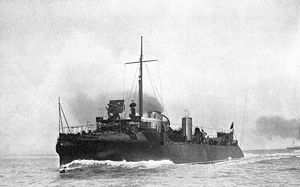A-class destroyer (1913)
This article includes a list of general references, but it lacks sufficient corresponding inline citations. (January 2013) |
 HMS Daring, the lead ship of the "26-knotter" group
| |
| Class overview | |
|---|---|
| Builders | Various |
| Operators | |
| Built | 1892–1895 |
| In commission | 1893–1920 |
| Completed | 42 |
| Lost | 3 |
| General characteristics | |
| Type | Destroyer |
| Displacement | From 185–340 long tons (188–345 t) |
| Length | 200–210 ft (61–64 m) |
| Propulsion |
|
| Speed | 26 kn (48 km/h) or 27 kn (50 km/h) |
| Complement | 46 to 53 |
| Armament |
|
The A class as designated in 1913 was a heterogeneous group of torpedo boat destroyers (TBDs) built for the Royal Navy in the mid-1890s. Some 42 vessels were constructed to the individual designs of their builders to meet Admiralty specifications, the only uniting feature being a specified top speed of 27 knots (50 km/h). In fact the initial six vessels were generally differentiated by a slightly lower speed and were often referred to as "26-knotters" to distinguish them from the following batch of thirty-six vessels; all fifteen surviving "27-knotter" vessels were classified by the Admiralty as the A class in 1913 to provide some system to the naming of HM destroyers. All of the "26-knotters" and most of the "27-knotters" had been lost or scrapped before the 1913 classification (and so - strictly speaking - never survived to become 'A' class), but for convenience all 42 ships are listed below. The number of funnels varied from one to four. All vessels had a distinctive "turtleback" forecastle that was intended to clear water from the bow, but actually tended to dig the bow in to anything of a sea, resulting in a very wet conning position.
They generally displaced around 260 tons and had a length of around 200 feet (61 m). All were powered by triple expansion steam engines and had coal-fired water-tube boilers (although initially, some had "locomotive type" fire-tube boilers in lieu). Armament was generally one QF 12 pounder on a bandstand on the forecastle, up to five QF 6 pounder and 2 single tubes for 18-inch (457 mm) torpedoes.[1] The six 1892-93 Programme ships initially had a third tube in the bow, fixed to fire straight ahead, but this was found to weigh down the bows and it was possible for the ship to run over its own torpedo when moving at high speed, so these were later removed and this feature was not repeated in later vessels.
Ships
The 26-knotter group
Six ships were ordered under the 1892-93 programme:
- Template:Sclass- destroyer; both built by John I. Thornycroft & Company, Chiswick.
- Template:Sclass-; both built by Yarrow Shipbuilders, Poplar.
- Template:Sclass-; both built by Laird Brothers, Birkenhead.
The 27-knotter group
Initially six torpedo boat destroyers (the Thornycroft and Yarrow vessels below) were ordered under the 1893-94 Programme, but a series of follow-up orders raised the programme to thirty-six vessels. The initial Estimates contained a sum of about £651,000 for payments on fourteen vessels, but the postponement of the First Class cruiser programme for that year allowed twenty-five destroyers to be ordered in that year, with the balance of eleven vessels funded under the 1894-95 Estimates (but still under the 1893-94 Programme).[2]
- Template:Sclass-; all built by John I. Thornycroft & Company, Chiswick.
- Template:Sclass-; all built by Yarrow Shipbuilders Ltd, Poplar.
- Template:Sclass-; all built by Laird Brothers, Birkenhead
- Template:Sclass-; all built by J. Samuel White, Cowes
- Template:Sclass-; both built by Hanna, Donald & Wilson, Paisley.
- Template:Sclass-; all built by Fairfields, Govan
- Template:Sclass-; both built by William Doxford & Sons, Sunderland.
- Template:Sclass-; all built by Palmers, Jarrow.
- Template:Sclass-; all built by Hawthorn, Newcastle upon Tyne.
- Template:Sclass-; all built by J & G Thomson (later to become John Brown and Company), Clydebank.
- Template:Sclass-; both built by Earle's, Kingston upon Hull.
- Template:Sclass-; all built by Naval Construction and Armament Company (later to become Vickers and eventually Vickers-Armstrongs), Barrow in Furness.
- Template:Sclass-; both built by Armstrong Mitchell and Company (later part of Vickers-Armstrongs), Elswick, Newcastle upon Tyne
- Zebra class; built by Thames Iron Works, Bow Creek
- Zebra, launched 13 December 1895, sold for breaking up 30 July 1914.
References
- ^ Lyon, op.cit., p.20.
Bibliography
- Chesneau, Roger & Kolesnik, Eugene M., eds. (1979). Conway's All The World's Fighting Ships 1860–1905. London: Conway Maritime Press. ISBN 0-85177-133-5.
- Colledge, J. J.; Warlow, Ben (2006) [1969]. Ships of the Royal Navy: The Complete Record of all Fighting Ships of the Royal Navy (Rev. ed.). London: Chatham Publishing. ISBN 978-1-86176-281-8.
- Dittmar, F.J.; Colledge, J.J. (1972). British Warships 1914–1919. Shepperton, UK: Ian Allan. ISBN 0-7110-0380-7.
- Friedman, Norman (2009). British Destroyers: From Earliest Days to the Second World War. Barnsley, UK: Seaforth Publishing. ISBN 978-1-84832-049-9.
- Gardiner, Robert & Gray, Randal, eds. (1985). Conway's All The World's Fighting Ships 1906–1921. London: Conway Maritime Press. ISBN 0-85177-245-5.
- Lyon, David (2001) [1996]. The First Destroyers. London: Caxton Editions. ISBN 1-84067-3648.
- Manning, T. D. (1961). The British Destroyer. London: Putnam & Co. OCLC 6470051.
- March, Edgar J. (1966). British Destroyers: A History of Development, 1892–1953; Drawn by Admiralty Permission From Official Records & Returns, Ships' Covers & Building Plans. London: Seeley Service. OCLC 164893555.
External links
 Media related to A class destroyer (1913) at Wikimedia Commons
Media related to A class destroyer (1913) at Wikimedia Commons
